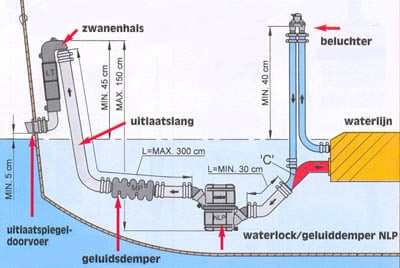This page has been translated with google translate, there may be errors in the stories.
With the engine running, cooling water is forced through the engine block by the impeller pump and eventually enters the discharge and leaves the boat with the discharge gases. If the engine is stopped, the supply of cooling water may not stop and the water siphons in. If this siphoning is not stopped, the engine will fill up with water and will cause water hammer when starting which can cause irreparable damage to the engine. Filling up the cylinder is only possible when the engine is no longer running, because the exhaust gases from the engine no longer press the cooling water out. Because not everyone wants to or can close their valve or simply sometimes forgets, an aerator in the cooling system is very important, because the aerator interrupts the siphoning because air is added. If the cooling system shut-off valve is closed, siphoning will stop or not be able to siphon. There are ships that are not equipped with an aerator, this is because if the head of the engine is above the waterline it would not be possible BUT unfortunately I encountered engines with the head well above the waterline and the engine anyway water.

Schematic operation.
Cooling water is forced through the engine block by the impeller pump and enters the exhaust (blue) and leaves the boat with the exhaust gases (red). When the engine is turned off, the discharge pressure stops and also the discharge pressure of the exhaust gases, which ensures that the cooling water is forced out of the exhaust hose. On many boats, the point where the warm cooling water enters the outlet is below the waterline and the outlet hose often goes up to a gooseneck or a transom grommet, this prevents the water from entering that path and siphoning begins. By placing an aerator high above the waterline, air is admitted into the cooling system when the engine is stopped, so that the siphon effect stops. The high water columns in the hoses below the aerator then push both the supply and discharge sides of the aerator empty to the waterline.
If you need an aerator, you can find it on this site with this link.





